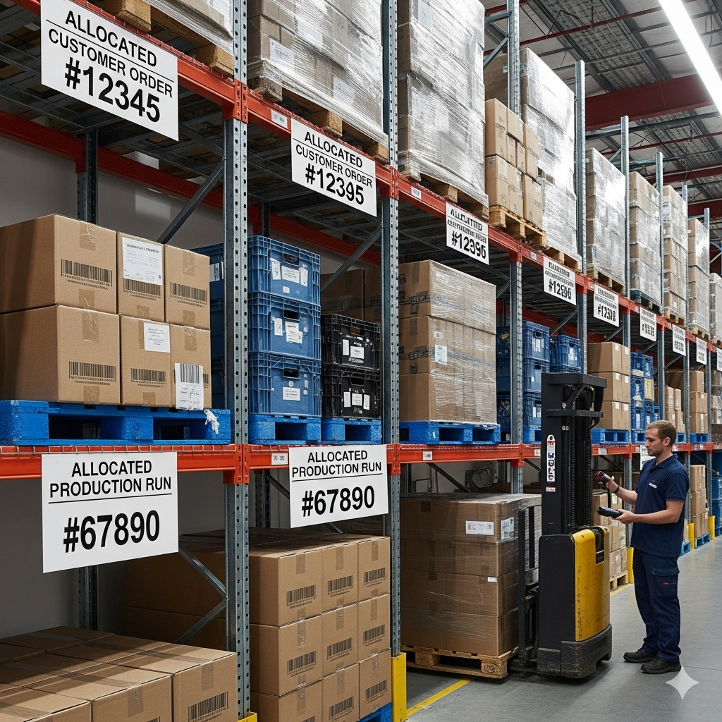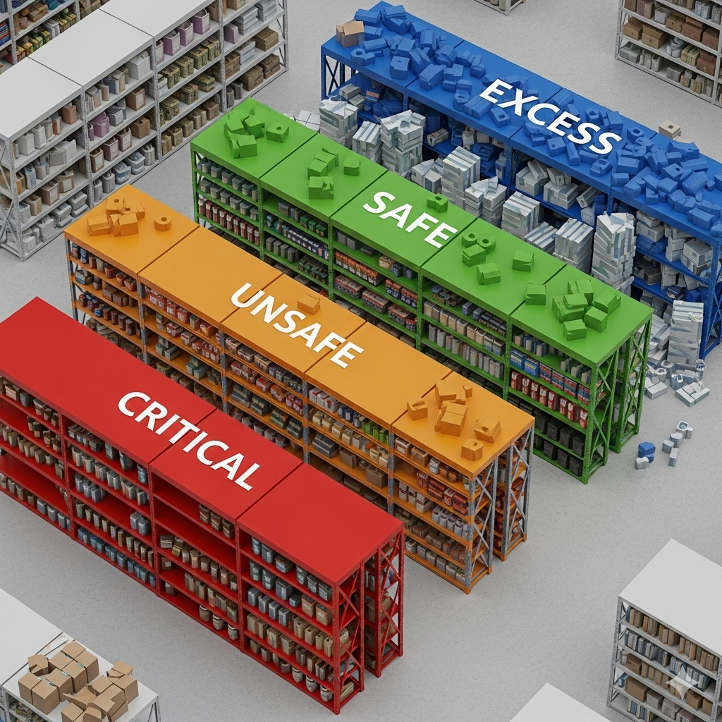
Is your Business Ready for the Holiday Season?
The holiday season is fast approaching, bringing with it significant shifts in consumer demand. Learn how to prepare your supply chain for seasonal demand spikes with AI-driven demand planning tools.
Simply counting floor stock isn't enough to manage a modern supply chain; today’s companies must track their inventory across multiple categories in order to optimize cash flow, meet customer expectations, and operate efficiently. Planners must understand the different types and statuses of inventory to drive smart decisions in purchasing, production, and logistics.
This guide explores key inventory classifications that every supply chain professional should understand, from availability statuses to sophisticated demand-based categories.
Reserved inventory represents stock that has been allocated to specific customer orders or production requirements. Reserved inventory carries the highest priority in your system because it's already committed to fulfill actual demand; it must be protected from all other allocation requests and carefully tracked to ensure on-time delivery performance. When calculating available-to-promise quantities, reserved inventory must be excluded from all availability calculations.

Pre-build inventory consists of items manufactured or assembled ahead of time dedicated for future use, often for seasonal demand or promotional campaigns. This classification is critical because pre-build inventory should not be included in standard days-of-supply calculations because it's earmarked for specific future periods. Proper tracking prevents bre-build inventory from being inadvertently allocated to current orders when it's reserved for planned future demand.
Inventory in quarantine status is physically present but unavailable for allocation due to quality assurance processes, regulatory compliance checks, or suspected defects. This inventory requires careful monitoring to avoid skewing availability reports while ensuring quality standards are maintained. Clear processes should govern how quickly quarantined inventory moves through inspection and either returns to available status or is designated for disposal.
In-transit inventory comprises goods that are physically moving between locations, whether from suppliers to warehouses, between distribution centers, or from warehouses to customers. While this inventory is company-owned, it's temporarily unavailable for allocation. Advanced supply chain systems track in-transit inventory to provide better visibility into exactly when goods will become available and to optimize transportation planning.
Work-in-Process inventory consists of partially finished goods that are currently moving through the production process. WIP inventory includes raw materials that have entered production, components in various stages of assembly, and products awaiting final processing steps. Managing WIP effectively is critical for manufacturing efficiency: too little WIP can cause production line stoppage while excessive WIP ties up capital, increases lead times, and can mask production problems. WIP levels are influenced by production batch sizes, cycle times, and the number of process steps in the manufacturing workflow.

Cycle inventory represents the planned inventory that cycles higher and lower based upon regular replenishment patterns and predictable demand consumption. This is the "working inventory" that fulfills normal customer demand between replenishment cycles. Cycle inventory levels are determined by economic order quantities, production batch sizes, and transportation constraints. Unlike safety stock, cycle inventory is consumed during normal operations and represents the average inventory investment required to support ongoing business operations efficiently.
Safety stock serves as a buffer against uncertainty in demand forecasting and supply lead times. This strategic inventory helps maintain service levels when actual demand differs significantly from forecasts or when supplier deliveries are delayed. The appropriate level of safety stock depends on forecast accuracy, lead time uncertainty, and desired service levels. With perfect forecast accuracy, safety stock would only need to account for supply-side variability such as delivery delays or quality issues. Regular review of safety stock levels ensures they remain aligned with current forecasting performance and business objectives.
Dormant inventory represents the ideal state where inventory levels are zero and no customer demand exists for the item. While this might seem problematic, dormant status can be appropriate for seasonal items during off-seasons, discontinued products that have been fully depleted, or items in transition between product lifecycle stages. Regular analysis helps identify truly dormant items versus those experiencing temporary demand lulls.
Unneeded inventory occurs when stock exists but no current or projected demand supports holding it. This classification often results from canceled orders, product discontinuations, or inaccurate demand forecasting. Unneeded inventory ties up working capital and storage space while providing no business value. Strategies for managing unneeded inventory include liquidation, return to suppliers, repurposing for other markets, or donation.
Out of stock indicates zero inventory availability when customer demand exists. This status triggers immediate action to restore inventory levels through expedited procurement, production rescheduling, or allocation from other locations. Persistent out-of-stock situations damage customer relationships and can result in lost sales and market share.
Critical inventory status applies when current stock levels are greater than zero but projected inventory will fall below minimum stock levels based on current demand patterns and replenishment lead times. This “early warning system” status enables proactive ordering to prevent stockouts. Items in critical status require immediate attention to avoid service disruptions.
Unsafe inventory levels exist when projected inventory falls between minimum stock levels and the projected safe inventory level. While not immediately critical, unsafe inventory status indicates elevated risk of stockouts if demand spikes or supply delays occur. This classification helps to prioritize purchasing activities and resource allocation.
Safe inventory levels indicate that projected inventory falls within the optimal range: above minimum safety requirements but below maximum policy limits. Items with safe inventory status typically require routine replenishment planning without urgent intervention. Safe status represents the target state for most inventory items under normal operating conditions.
Excess inventory occurs when projected stock levels exceed maximum policy limits based upon demand forecasts and storage capacity constraints. Excess inventory ties up capital, increases holding costs, and may lead to obsolescence. Strategies for managing excess inventory include promotional pricing, redistribution to other locations, or adjusting future procurement plans.

SLOB inventory combines multiple problematic characteristics: items move slowly through the supply chain, may be approaching obsolescence, or fail to meet current quality standards. This classification requires special handling strategies including liquidation, rework, or disposal. Regular SLOB analysis helps identify process improvements to prevent future accumulation of problematic inventory.
Dead stock represents inventory that has no demand over an extended period and little prospect for future sales. Unlike dormant inventory, dead stock typically results from poor forecasting, product failures, or market changes. Dead stock requires aggressive disposition strategies to minimize financial impact and free up warehouse space.
Allocated inventory is stock that has been designated for specific purposes but is not yet physically reserved. This might include inventory allocated to specific sales channels, regions, or customer segments. Proper allocation management ensures fair distribution of limited inventory while maintaining flexibility to respond to changing market conditions.
Consignment inventory remains owned by a supplier but is stored at the customer's location for immediate availability. This arrangement reduces customer working capital requirements while ensuring supply availability. Consignment inventory requires careful tracking to maintain accurate ownership records and payment obligations.
Lot-tracked inventory is classified and managed by specific production batches, lots, or serial numbers to enable precise traceability throughout the supply chain. This classification is essential for industries with regulatory requirements (pharmaceuticals, food, automotive) and enables rapid, targeted responses to quality issues or recalls. Lot tracking supports inventory age management by identifying the oldest stock for first-out rotation, ensuring products don't exceed shelf life or expiration dates. Advanced lot tracking systems maintain complete genealogy records, tracking which raw material lots contributed to finished goods, enabling precise root cause analysis when quality issues arise.
Serialized inventory is traceable to the individual stock unit level and requires that each item has a unique identifier. This type of granular tracking is critical for high-value items, regulated products, or items requiring warranty tracking. Serialized inventory enables precise location tracking, ownership history, and individual unit performance monitoring throughout the product lifecycle.
Raw materials represent basic inputs that will be transformed through manufacturing processes into finished products. These materials are typically purchased from suppliers and stored until needed for production. Raw materials inventory management focuses on ensuring adequate material supply to prevent production disruptions while minimizing holding costs and obsolescence risk. Lead times for raw materials are often longer and less predictable than for finished goods, requiring careful demand planning and supplier relationship management.
Components and sub-assemblies are partially processed materials that have been manufactured or assembled from raw materials but are not yet complete finished products. This category includes purchased components from suppliers as well as internally manufactured sub-assemblies. Components inventory requires careful coordination between production schedules and assembly operations, as shortages of any single component can halt final assembly. Managing components inventory often involves complex bills of material (BOM) relationships and requires sophisticated planning systems to ensure all parts arrive when needed.
Finished goods represent completed products ready for sale and shipment to customers. This inventory typically has the highest value per unit and the shortest remaining lead time to customer delivery. Finished goods inventory management focuses on balancing customer service levels with inventory investment, as these items are closest to generating revenue. Demand planning for finished goods must consider customer ordering patterns, seasonality, and promotional activities while managing the risk of obsolescence as products approach end-of-life.
Modern inventory management systems should automatically classify inventory based on predefined rules and real-time data. Automated classification reduces manual errors, ensures consistency, and enables rapid response to changing conditions. Regular review of classification rules ensures they remain aligned with business objectives.
Establish regular review cycles for each inventory classification to ensure accuracy and relevance. High-value or fast-moving items may require daily review, while stable items might be reviewed monthly or quarterly. Consistent review processes help identify trends and opportunities for improvement.
Effective inventory classification requires collaboration between purchasing, production, sales, and finance teams. Each function brings unique perspectives on demand patterns, cost implications, and operational constraints. Regular cross-functional meetings ensure alignment on classification criteria and action plans.
Develop key performance indicators for each inventory classification to measure management effectiveness. Metrics might include inventory turns by classification, service levels for critical items, or reduction in excess inventory over time. Regular performance monitoring enables continuous improvement in inventory management practices.
Understanding and properly implementing inventory classifications and statuses creates a foundation for sophisticated supply chain management. Such categorizations enable more precise decision-making, better resource allocation, and improved customer service levels. As supply chains become increasingly complex, organizations that master inventory classification will gain competitive advantages through optimized working capital, reduced operational costs, and enhanced customer satisfaction.
The key to success lies not just in understanding these classifications, but in implementing systems and processes that automatically maintain accurate status information and trigger appropriate actions. Regular review and refinement of classification criteria ensures that your inventory management approach evolves with changing business needs and market conditions.
By leveraging inventory classifications effectively, organizations can treat inventory as a strategic asset that drives business growth and customer satisfaction.

JR has 2 decades of experience in Demand and Supply Planning helping customers achieve desired results.
October 6, 2025

The holiday season is fast approaching, bringing with it significant shifts in consumer demand. Learn how to prepare your supply chain for seasonal demand spikes with AI-driven demand planning tools.

Introduction In the beverage industry , where demand fluctuations and supply chain complexities are common, having robust supply chain demand planning software is crucial. These tools help beverage co

Established supply chain software company Areté has chosen the IONOS Cloud to help it offer customers a hosted solution.Hold a bottle of soda, and you’re looking at the result of a logistics challenge